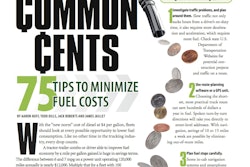Trucking news and briefs for Tuesday, July 20, 2021:
Brake Safety Day nets more than 1,100 out-of-service violations
Commercial motor vehicle inspectors in the U.S. placed 1,151 vehicles out of service because of brake violations during a one-day inspection effort in May.
The Commercial Vehicle Safety Alliance said authorities in the U.S. inspected 8,658 vehicles during its annual Brake Safety Day May 26.
“Inspectors conducted their usual inspections and reported brake-related data to CVSA for Brake Safety Day,” said CVSA President Sgt. John Samis with the Delaware State Police. “We are sharing the results to call attention to the importance of commercial motor vehicle brake safety.”
In Canada, Mexico and the U.S., inspectors conducted a total of 10,091 inspections and placed 1,273 vehicles out of service for brake-related violations. The majority of inspections were conducted in the U.S., with 8,658 of the 10,091. There were also 946 inspections in Canada and 487 inspections in Mexico.
During the one-day enforcement effort, the brake-related out-of-service rate for all of North America was 12.6%. The rate in the U.S. was 13.3% (1,151 trucks placed OOS), while it was 11.4% (108 trucks) in Canada and 2.9% (14 trucks) in Mexico.
In addition, inspectors compiled and reported data specifically on brake hoses/tubing, the focus area for this year’s Brake Safety Day. There were a total of 1,725 brake hoses/tubing violations across North America, according to CVSA.
Brake Safety Day is the alliance’s unannounced brake safety initiative. However, CVSA also holds Brake Safety Week each year and announces those dates publicly well in advance. This year’s Brake Safety Week is scheduled for Aug. 22-28.
FMCSA shuts down trucker for OOS order violation
The Federal Motor Carrier Safety Administration has effectively shut down Tennessee-licensed truck driver Kristopher Anthony Adams following a crash that occurred after he was placed out-of-service.
On June 9, Adams was driving a truck in Adair County, Kentucky, when his vehicle drifted into the opposing lane and collided with another vehicle. At the time of the crash, Adams was operating in violation of an out-of-service order he had received less than 24 hours earlier.
On June 8, while operating in Branch County, Michigan, he bypassed an open weigh station. Stopped by a Michigan State Police officer, Adams admitted to the use earlier in the day of a Schedule II drug and was immediately ordered out-of-service.
Despite the Michigan OOS order, Adams continued operating his truck leading up to the June 9 crash in Kentucky.
In March 2020, during a federally mandated pre-employment drug and alcohol screening test, Adams tested positive for methamphetamine and amphetamine, and thereby became disqualified from operating a CMV until he completed a required return-to-duty process overseen by a Substance Abuse Professional.
In a blatant disregard of federal controlled substances prohibitions, Adams continued to operate a commercial motor vehicle, and in August 2020, he was involved in a single-vehicle crash in Kentucky. Three months later, he was subjected to two separate unannounced roadside inspections in Georgia and received citations for safety violations on both occasions.
Failing to comply with the provisions of the federal imminent hazard order may result in civil penalties of up to $1,951 for each violation. Knowing and/or willful violations may result in criminal penalties.
Reefer fleet raises driver pay
J.S. Helwig & Son, a temperature-controlled carrier based in Texas is raising pay for its drivers.
The company announced last week a pay increase of 4 cents per mile across the board, raising the starting pay to 55 CPM.
Additionally, drivers will receive a raise at six months and then annually for the opportunity to earn up to 62 CPM, according to a statement from the company.
Over the previous year, Helwig has increased pay by an average of 10 CPM. Additionally, the company has added a repower bonus and shortened the amount of time for drivers to reach seniority-based pay increases.














